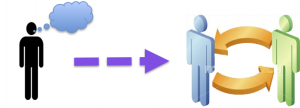 Basic Research Questions:
Basic Research Questions:1. How do individuals with schizophrenia and Autism Spectrum Disorders establish joint attention with another individual to achieve a common goal?
2. How do these individuals form common conceptual ground?
3. Further, how do turn taking dynamics differ during conversation?
Moment-by-moment coordination among conversational partners is necessary because for each utterance, they must establish the mutual belief that the addressee has attended to, heard, and understood what the speaker uttered, said, and meant, well enough for current purposes. Such joint actions, as in the uttering/attending action, require coordination because they are interdependent. Research to date has examined coordination in situations where partners synchronize each other’s behavior via imitation or entrainment. Coordination in conversation is special because it emergences from the interdependence between the individual (and different) actions that conversational partners take. Using a task in which conversational partners collaborate to reproduce an array of hard-to-name shapes without having visual access to each other’s workspace, we are assessing the degree to which, compared to healthy controls, patients with schizophrenia or an Autism Spectrum Disorder collaborate and coordinate with their interlocutors to achieve the task’s goals, both at the level of their goals and joint actions and in their turn-taking dynamics.
This task is done in coordination with Dr. Delphine Dahan.
Clinical Application
•This study is a first step toward the development of a paradigm suitable for studying conversations in a cognitively impaired population and will establish a benchmark for behavioral dependent variables that can be used reliably to measure the establishment of common conceptual ground and turn-taking dynamics.
•Modeling conversation in clinical populations provides key insights to the nature of the difficulties in conversing experienced by patients, as well as to ways in which such deficits can be remediated.
Behavioral Task
Participants are paired with a confederate, who acts as another participant. They are each be given a set of 16 shapes (out of 600 total figures derived from tangram configurations.) One partner will act as the “director,” while the other acts as the “matcher.” The director is given a booklet with a series of 3 shape sequences. The director must verbally guide the matcher to produce each sequence. The role of the participant (director or matcher) and that of the confederate alternates across trial groups. Each of the 16 tangram figures is used 3 or 4 times within the session, varying whether a repeated reference is done by the same person as that who introduced it or not. The experimenter remains inside the testing room, recording the time taken for each trial, observing non-verbal interactions, and recording whether the matcher’s sequence matches the director’s and if not, which of the figures was erroneously swapped. The session is also audio-taped for later acoustic analysis.

Comments are closed.